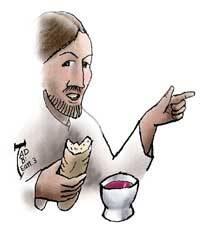You Are Witnesses
The Gospel for today has many resonances with the Gospel for the Second Sunday of Easter (Jn 20:19-31). In both accounts the risen Christ appears to the disciples and stands “in their midst.” In both, his first words are “Peace be with you”; then he shows them his hands, feet and side. In both accounts the disciples move from terror to joy. Both stories end with a sending of the disciples in mission.
Despite the many similarities, however, the theological emphases in the two accounts are quite different. Luke focuses on the identity of the risen Christ and his reality and tangibility. Unlike the story of Thomas in John’s Gospel, which focuses on believing, in the Gospel of Luke, the reason for the disciples’ seeing and touching Jesus’ hands and feet is to convince them that the risen one is the same Jesus who was crucified and who still bears the marks of this on his body, though he is real and alive. Jesus is not just a memory that lives on, nor is he a haunting ghost; instead he is truly alive and tangible. Unlike the preceding Emmaus scene, where Jesus’ eating with the two disciples is revelatory and eucharistic, in today’s Gospel Jesus’ eating serves as proof that he is truly alive and tangible in bodily form.
In the second half of Luke’s Gospel, the focus shifts to the mission of the disciples as witnesses to the suffering Messiah who is raised. Key to being a witness are an understanding of the Scriptures, repentance and forgiveness of sins. These same emphases are echoed in today’s first reading.
Peter’s speech is set in Solomon’s Portico in the Temple; it follows his healing of a man who was crippled and who begged daily at the Beautiful Gate. Peter harshly accuses his fellow Jews, placing on them all the blame for handing over Jesus and for putting to death the “author of life.” But the Gospel writer’s focus is not on fixing blame for the death of Jesus; rather, the focus is on God’s power in raising Jesus.
Peter excuses all those who were complicit in Jesus’ death, saying that they acted out of ignorance; this is similar to what the Lucan Jesus does as he prays from the cross, “Father, forgive them; they know not what they do” (23:34). Luke consistently portrays Jesus as a rejected prophet and explains his death as the fulfillment of Scripture. The notion of a suffering messiah, found in the first reading and in the Gospel, is one that occurs only in Luke’s writings (Lk 24:26, 46; Acts 3:18, 17:3; 26:23); it is not found in any Old Testament texts.
Immediately linked to the affirmation that the Messiah must suffer is the invitation to repentance and forgiveness. Repentance and acceptance of forgiveness is not guilt-induced; it is the only adequate response to God’s gift of new life, offered in restored relationship with the risen Christ. Witnessing to this love and power begins at home (Jerusalem), then radiates out “to all the nations.”
This article also appeared in print, under the headline “You Are Witnesses,” in the April 20, 2009, issue.








